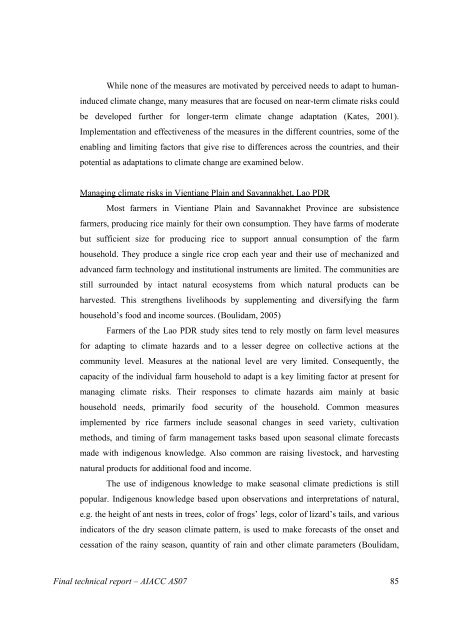Final Technical Report - weADAPT
Final Technical Report - weADAPT
Final Technical Report - weADAPT
- No tags were found...
You also want an ePaper? Increase the reach of your titles
YUMPU automatically turns print PDFs into web optimized ePapers that Google loves.
While none of the measures are motivated by perceived needs to adapt to humaninduced<br />
climate change, many measures that are focused on near-term climate risks could<br />
be developed further for longer-term climate change adaptation (Kates, 2001).<br />
Implementation and effectiveness of the measures in the different countries, some of the<br />
enabling and limiting factors that give rise to differences across the countries, and their<br />
potential as adaptations to climate change are examined below.<br />
Managing climate risks in Vientiane Plain and Savannakhet, Lao PDR<br />
Most farmers in Vientiane Plain and Savannakhet Province are subsistence<br />
farmers, producing rice mainly for their own consumption. They have farms of moderate<br />
but sufficient size for producing rice to support annual consumption of the farm<br />
household. They produce a single rice crop each year and their use of mechanized and<br />
advanced farm technology and institutional instruments are limited. The communities are<br />
still surrounded by intact natural ecosystems from which natural products can be<br />
harvested. This strengthens livelihoods by supplementing and diversifying the farm<br />
household’s food and income sources. (Boulidam, 2005)<br />
Farmers of the Lao PDR study sites tend to rely mostly on farm level measures<br />
for adapting to climate hazards and to a lesser degree on collective actions at the<br />
community level. Measures at the national level are very limited. Consequently, the<br />
capacity of the individual farm household to adapt is a key limiting factor at present for<br />
managing climate risks. Their responses to climate hazards aim mainly at basic<br />
household needs, primarily food security of the household. Common measures<br />
implemented by rice farmers include seasonal changes in seed variety, cultivation<br />
methods, and timing of farm management tasks based upon seasonal climate forecasts<br />
made with indigenous knowledge. Also common are raising livestock, and harvesting<br />
natural products for additional food and income.<br />
The use of indigenous knowledge to make seasonal climate predictions is still<br />
popular. Indigenous knowledge based upon observations and interpretations of natural,<br />
e.g. the height of ant nests in trees, color of frogs’ legs, color of lizard’s tails, and various<br />
indicators of the dry season climate pattern, is used to make forecasts of the onset and<br />
cessation of the rainy season, quantity of rain and other climate parameters (Boulidam,<br />
<strong>Final</strong> technical report – AIACC AS07 85
















